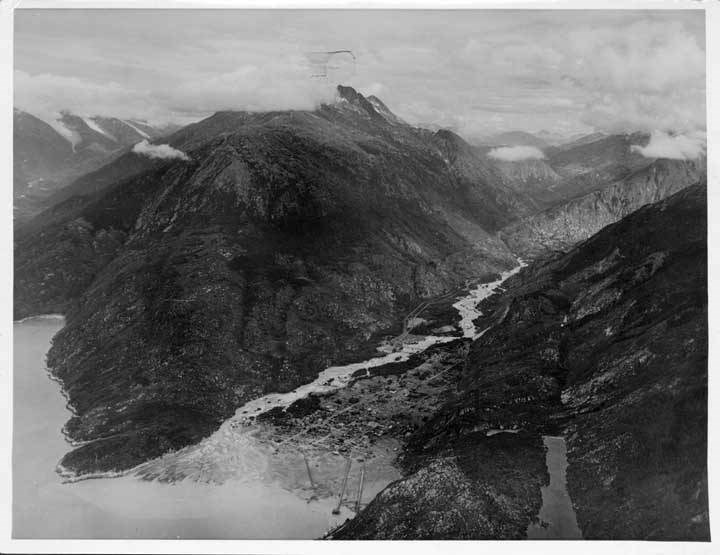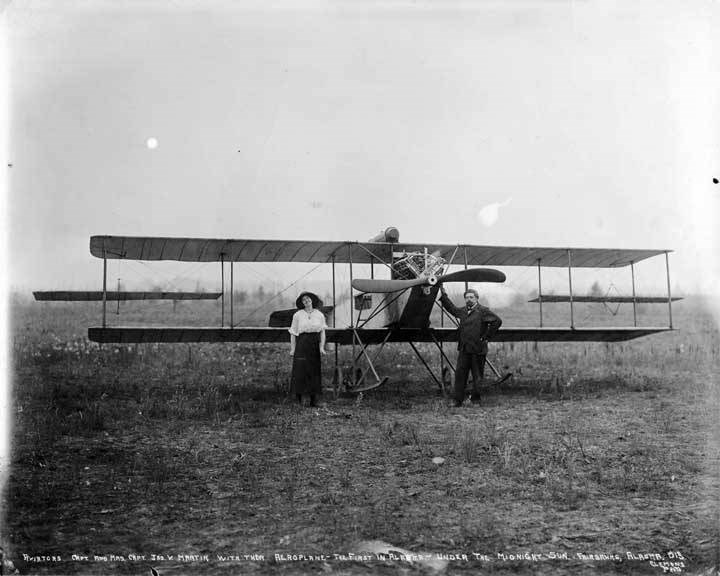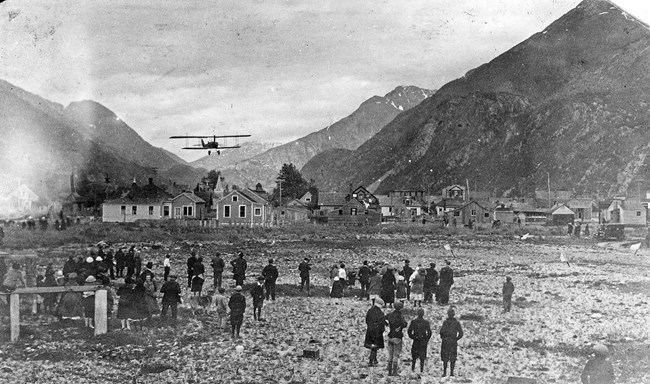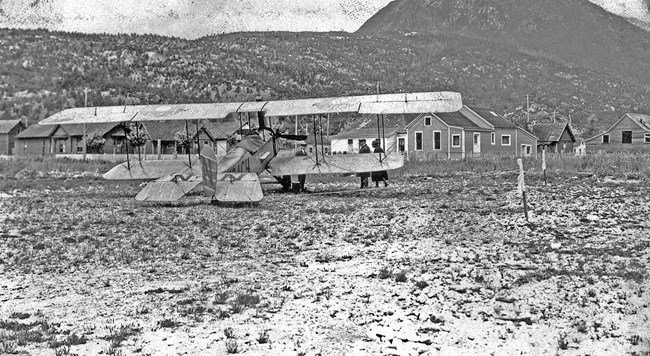Last updated: October 26, 2021
Article
The First Aeroplane in Skagway

Alaska State Library, George A. Parks. Photographs, 1911-1933, ASL-PCA-240-097.
The first aeroplane (and that’s a.e.r.o. plane as they spelled it then) to come to Skagway didn’t make much news because it was boxed in a crate. Early aviator James Vernon Martin was a guest speaker at the Seattle Press Club on March 10, 1912. He so impressed some visiting Fairbanks businessmen that he was invited, along with his wife Lilly Irvine, who was England's first woman aviatress, to come to Fairbanks to give Alaska its first flying demonstration in a heavier-than-air machine. The Martins shipped their crated airplane from Seattle to Skagway by steamer, from Skagway to Whitehorse by railroad, and from Whitehorse to Fairbanks by river boat. Once at Fairbanks, Martin and his wife assembled their airplane. Then on the evening of July 3, 1913, Captain Martin took off from Exposition Park and flew the plane over Fairbanks at an altitude of 200 feet and speeds of up to 45 miles per hour. Later they lectured on flying at the Fairbanks opera house. The couple made five flights in three days at Fairbanks, the first airplane flights ever in Alaska. During the time they were in the city, they tried unsuccessfully to sell their airplane – a Gage-Martin Tractor bi-plane but since they could not sell it, they crated it up again and shipped it via St. Michael to their home in San Francisco.

Alaska State Library, Harold and Leila Waffle Photograph Collection, ca. 1912-1918, ASL-PCA-281-082.
The first time the good citizens of Skagway actually saw an airplane in flight was on August 16, 1920, on the 24th anniversary of gold discovery in the Klondike, and it merited front page news in Skagway’s Daily Alaskan newspaper. The August 17th edition of the paper exclaimed:
There was surely some excitement in Skagway yesterday when the shout went up that the aeroplanes were coming. The first one arrived at three thirty in the afternoon and was seen by almost everyone in town and it was certainly a beautiful sight. The plane was sailing low and could be seen in [some] detail as the birdman was evidently taking pictures.
As the plane went up the valley the pilot kept it down pretty low and passengers on the train coming down the mountain had to look down on it as it passed up Deadhorse Gulch above White Pass City. The plane landed in Whitehorse at four forty five… The flyer followed the White Pass and Yukon Route almost all the way as he flew over every station along the route.

National Park Service, Klondike Gold Rush National Historical Park, Candy Waugaman's Collection, KLGO Library TA-8-8917.
These four planes were de Havilland DH-4B bombers of the U. S. Army Air Service’s Alaska Flying Expedition. The Army’s "Black Wolf" squadron, as they were called, had started out from Long Island, New York and eventually reached the old parade ground at Nome's Fort Davis and then turned around and returned to New York by an alternative route. An advance party had traveled through Skagway in June 1920 in order to scope out the route and in some cases, like Whitehorse, actually build rough airfields for the planes to land and refuel. The flight was the brainchild of Brigadier General William (Billy) Mitchell and the Daily Alaskan newspaper followed the flight to its successful conclusion.
The first person to actually land an airplane in Skagway was Clearance Oliver Prest otherwise known as Ollie. Born in 1896, Prest designed his first plane in 1909. He had attempted to fly from Mexico to Siberia in 1921 but without the logistical support supplied to the Army in 1920. He started out from Venice, California, flew down to Tijuana, Mexico for some reason, and then headed northward in a leisurely manner barnstorming as he went along to raise money to pay his expenses. He would put on airshows in rural areas. This was not a problem until he crossed into Canada where his fund raising activity eventually led to his arrest in Prince Rupert, British Columbia. A few days later his Curtiss JN-4 Jenny named the “Polar Bear,” was wrecked at Prince Rupert, during an overnight wind storm. Quite popular with the town’s citizens, Prince Rupert officials quickly brought about his release and Prest vowed to try again in 1922.
The next year, Prest bought a Standard J-1 bi-plane trainer repowered by a 90 horse power Curtiss OX-5 engine at the Curtiss Aeroplane and Motor Company, Buffalo, New York. He then flew across country, barnstorming along the way, until he reached Seattle on June 23, 1922. Due to the problems the previous year, Canadian authorities refused to allow his flight into Canada so he loaded his aircraft on the Steamer Alameda and sailed to Juneau, arriving there on July 1. Prest then reassembled his machine at nearby Thane and gave an exhibition flight for the 4th of July celebrations. He took off for Skagway on July 6.

National Park Service, Klondike Gold Rush National Historical Park, Candy Waugaman's Collection, KLGO Library TA-9-8918.
Aviator C. O. Prest arrived in Skagway this afternoon at 3:25 and landed against the wind on the beach beside the Sylvester wharf in safety, just one hundred and twenty feet from where the wheels of the plane first touched the ground. A good crowd had gathered on the beach to welcome this pioneer of the air, and first sighted the plane at 3:15 as it sailed mountain high above the channel. The hop was taken from Juneau at two o’clock and in one hour and twenty-five minutes the distance of about 100 [miles] had been covered. After a spin around the town to get his bearing, the aviator descended rapidly to the north and in a graceful curve headed for the beach that had been cleared of stone and sticks, and lined with white flags, making a lane of fifty feet in width and several hundred feet long. It was the surprise of the onlookers to see such an excellent landing and the tourists present, who are used to seeing planes land, said it was accomplished in “a most unusual and graceful manner.” Mr. Prest has the distinction of being the first airman to land in Skagway.
On the tail of the plane could be seen the words, “Prest, Polar Bear II, Las Vegas, Nevada.” Mr. Prest has made his home for the past two years at this place but began his present flight from Buffalo, N. Y.
The aviator will remain in the city until tomorrow afternoon when he will continue his air voyage landing at Whitehorse, Y. T., perhaps an hour later. The people of Skagway and those of the tourists wish him a successful trip to his destination in Asia. Mr. Prest actually stayed in Skagway for a couple of days and then he gave an exhibition flight on the day he left, July 8, 1922.
The early twentieth century is marked by massive changes throughout the world: new challenges, new possibilites. These were exciting times for all, and "aero"planes, whether they arrived in a crate or in the air, heightened that sense of excitement by opening up remote parts of the world like Skagway, Alaska.
